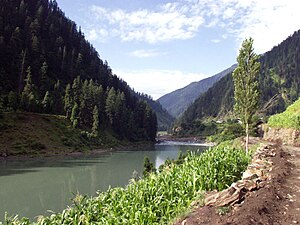Ap (water)
Ap (áp) is the Sanskrit name for water in the Vedas . In classical Sanskrit, the word only appears in the plural as āpas , from which a singular āpa- can then be regressed .
etymology

Ap emerged from the Indo-European root h x ap , also meaning "water". As an Indo-Iranian word , it survived in the Persian word for water, āb , from which, for example, Punjab was formed. Punjab ( panj-āb ) literally means "five waters", meaning the five great rivers of the Indus plain. There is also a connection to the language isolate of Sumerian , the word for ocean , sea ab .
In archaic, laryngeal contractions of ablaze in Vedic Sanskrit, the Indo-European root remains recognizable. For example, pratīpa with the meaning “against the current” is derived from proti-h x p-o- .
Meaning in the Vedas
In the Rigveda there are several hymns dedicated to the waters (āpas): 2, 35 , 7.49 , 10, 9 , 10.30 and 10.47. In the latter stanza the waters are related to the drought sent by Indra . The fire god Agni also has a close connection to water and is often referred to as Apām Napāt ( descendant of water ). The female deity Apah is the ruler of the Purva Ashada (in German front invincible ) in Vedic astrology .
In Hinduism , the term Ap stands for the element water and belongs to the Panchamahabhuta , the five great elements. It can also stand for Varuna , the personification of the water, which was included in the Vasu in later listings of the Puranas .
Meaning in the Avesta
The water genius Apas (also āpas ) in the Avesta , which is homologous to the Veda , is derived from the singular āpō , from which the feminine plural āpas was formed. The water spirits are thus female. Equivalent forms in Middle Persian are ābān / Ābān (with the alternative forms āvān / Āvān ). From this it was in Gujarati then Ava / Ava forth, but which is used only in the religious sphere. The avestic noun āpas thus exactly matches the Sanskrit name and both refer to the Proto-Iranian root * ap- .
Water is consequently represented by the Apas, a group of water deities - whether as individual drops or waves or collectively as streams, ponds, rivers or fountains. In both cultures, a complete correspondence between deity (s) and the element is achieved. Therefore, the Rigveda also sees it as healing to drink the water geniuses and the Avest recommends taking a bath in them.
In Zoroastrianism a profound reverence is anchored for water up to the present day. This is already evident from the fact that in addition to the Apas, seven deities alone are consecrated to the element of water. In strict households, ritual offerings are regularly made to the local well or the river. The ape zaothra ceremony of Yasna literally means strengthening the water .
For a more detailed description see Aban .
See also
- Aban (Avesta)
- Abzu , the Sumerian primeval ocean .
- Doab , the name in North India for the land between two flowing rivers
- Punjab .
Individual evidence
- ↑ a b Mary Boyce : History of Zoroastrianism, Vol. I . Brill, Leiden 1975, ISBN 90-04-10474-7 .